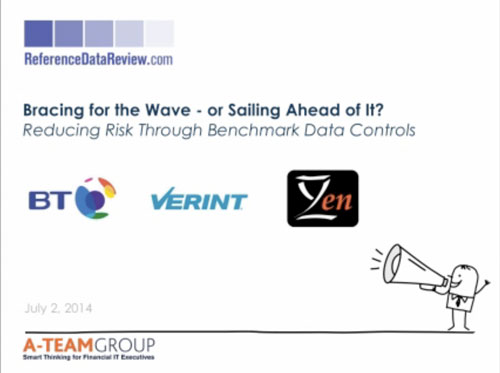News from BT Global Banking and Financial Markets
LIBOR: could we have seen it coming?
The repercussions of the LIBOR price fixing scandal are likely to run and run.
We now know that from around 2005 onwards a number of banks were attempting to manipulate rates. Over $6 billion has already been levied in fines, and with $300 trillion-worth of contracts pegged to this all-important benchmark, the figure could well run to $20-30 billion over coming years as those affected recalculate their damages on the basis of what LIBOR should have been at the time.
 Both the regulators and banks have been slow to react, but it is now clear that the wave of LIBOR-inspired compliance requirements that have resulted from the scandal have particular implications for capital markets.
Both the regulators and banks have been slow to react, but it is now clear that the wave of LIBOR-inspired compliance requirements that have resulted from the scandal have particular implications for capital markets.
Participants are concerned that they will be ‘unfairly’ penalised by regulation, which will cause them to lose competitive traction – and they are struggling to rationalise compliance processes and platforms over many disparate geographies and wildly different jurisdictions.
What is also clear is that at the time of the price fixing scandal, off the shelf automated surveillance systems already existed that could have picked up anomalous trading patterns and alerted compliance officers at the time to what was happening.
“We clearly don’t seem to know
what’s going on out on the trading floor in even a basic sense and
certainly we are not measuring”
“Somebody in compliance should have been running some of these basic statistical predictive analytics tests on what is clearly an intrinsically important benchmark in a major market area,” says Professor Michael Mainelli of Z/Yen. “I would contend that the industry has a lot to learn, and to start learning you have to admit what you don’t know. We clearly don’t seem to know what’s going on out on the trading floors in even a basic sense and certainly we’re not measuring.”
CFOs and corporate treasurers are now waking up to this fact and are anxious to stop history repeating itself. Proactive management of a firm’s risk and compliance environments is desperately needed to stay ahead of the compliance wave.
But what action can and should they take? The new regulations call for ongoing proactive monitoring, but voice remains central to much trading floor activity, and because these data records are unstructured they need to be analysed once captured.
Existing voice surveillance systems used by banks tend to be manual and therefore extremely resource intensive, expensive and time-consuming. It can take four hours to listen to one hour of voice content, says Verint’s Robert Simpson; fewer than 15 per cent of people involved in the process can be monitored at any one time – so this is clearly not a scalable process.
Speech analytics technology is capable of delivering up to 75 per cent accuracy. But banks have been hesitant to adopt it, claiming that the technology is bleeding edge, hence unproven, and unsuitable for wholesale banking environments where there is so much background noise.
BT’s Tim Furmidge, Head of Product Management, Financial Technology Services illustrates how such systems can be introduced in a staged way in this thought provoking video webinar that demonstrates how proactive management of firms’ risk and compliance environments can not only help them stay ahead of the regulatory wave, but also deliver significant productivity gains.